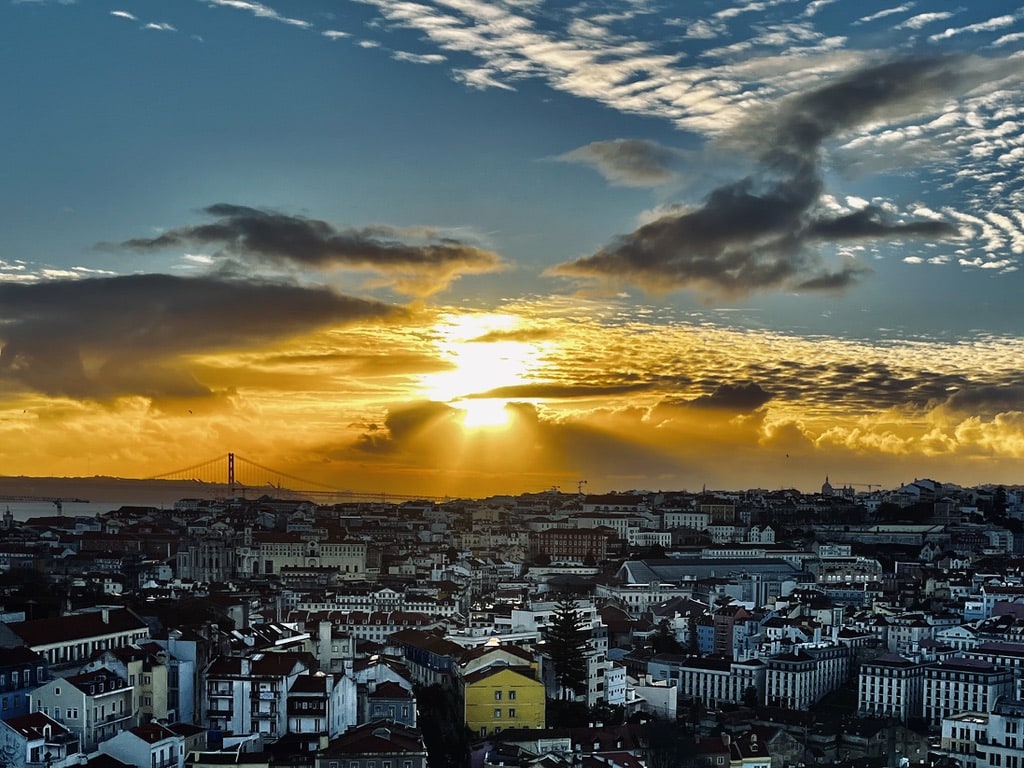Portugal Road Trip: A 7-Day Adventure from Lisbon to Porto
Every February, I face the same dilemma: should I hit the slopes for a skiing adventure or try to escape to a country with a milder climate? In 2023, I chose a week-long trip to Spain and had a great time. This year, I’ve chosen to embark on a Portugal road trip. Despite its climate being influenced by the Atlantic Ocean, it has proven to be the perfect decision. Just be mindful that it might rain, so packing an umbrella is a wise decision.
Table of Contents
Practical Insights:
Arrival in Portugal:
Portugal being part of the Schengen zone ensures a hassle-free experience for travelers arriving from another Schengen zone country, with no passport checks. If you are from a non-EU country, check your passport status to meet the requirements for entering the Schengen zone.
Currency:
The official currency in Portugal is the Euro. Card payments are widely accepted, and ATMs are easily accessible if needed.
Renting a Car:
I chose the Hertz rental company for a specific reason. I wanted to rent a car in Lisbon and return it in Porto. Based on my research, not all rental companies allow this option and there is a a special charge for it. Returning a car in Porto can be a bit tricky since rental companies don’t operate 24 hours at Porto airport. Therefore, if you have an early morning flight, I suggest to return the car the day before and rely on Uber or Bolt from that point.
Driving:
Driving in Portugal is straightforward, similar to any other EU country. Petrol stations are conveniently located. The maximum speed limit on highways is 120 km/h, and in towns, it’s 50 km/h.
Mobile Data:
EU citizens benefit from “roam-like-at-home,” eliminating worries about purchasing additional data packages. For those outside the EU, I recommend using the Airalo app, which allows you to download a data e-SIM card for countries worldwide. It’s a simple and hassle-free solution.
Day 1: Arrival to Lisbon
We landed in Lisbon on Saturday afternoon. Upon arrival, we picked up our pre-booked rental car from the Hertz office, conveniently located in the airport terminal. As with all my trips, I chose accommodation with private parking to avoid the hassle of searching for parking spots in the city and understanding local street parking rules. The Legendary Suites Apart Hotel not only offers an underground garage but is also conveniently situated near an underground stop. For me, the subway is always the best and easiest way to explore the city.
After checking in, we headed to the town. Using the “blue” metro line to the Santa Apolonia station, we walked toward the Panteão Nacional. The church has served as the burial place for Portugal’s royals and notable cultural figures for many years. Unfortunately, the winter opening hours are shorter, and we got there late to explore it inside. From there, we wandered around the old Alfama neighborhood.


Eventually, we were tired enough to have dinner. Right in the city center, we found Pizzaria Tapas La Casa. The waiter was amazing. He greeted us in our own language (which was totally rad, as who speaks Czech?). After that, he seamlessly switched to perfect German, followed by conversing with other guests in Portuguese, English, and Spanish.
The pizza and wine were perfect.
Day 2: Lisbon Landmarks Beyond the City Center & Cabo de Roca
Jerónimos Monastery
Our first stop of the day was Jerónimos Monastery. Dating back to the 5th century, it holds a fascinating history, including Vasco da Gama spending the night here before his expedition to the Orient.
We drove and parked right in front of the monastery. There are plenty of free parking spaces in the area. Despite arriving at around 9:30 am, the opening time, and it being February, not a peak tourist season, we still had to wait in line for 10 minutes to get in. Tickets for the monastery can be purchased on the spot, but I opted to buy them online.


Padrão dos Descobrimentos
Opposite the Jerónimos Monastery, on the Tagus riverbank, stands the Padrão dos Descobrimentos. This impressive 52m high monument commemorates Portuguese explorers who embarked on voyages across the ocean to discover a new world in the 15th and 16th centuries. The monument resembles a ship with statues of explorers on the side. An observation deck is also available for those who choose to visit. It’s worth taking a look at the pavement in front of the monument, where a huge mosaic map, donated to Portugal by the South African government, can be found.
Belém Tower
A walk alongside the river leads to the Belém Tower. Once a defense tower and an iconic landmark for sailors navigating back home, it is now a UNESCO World Heritage site.

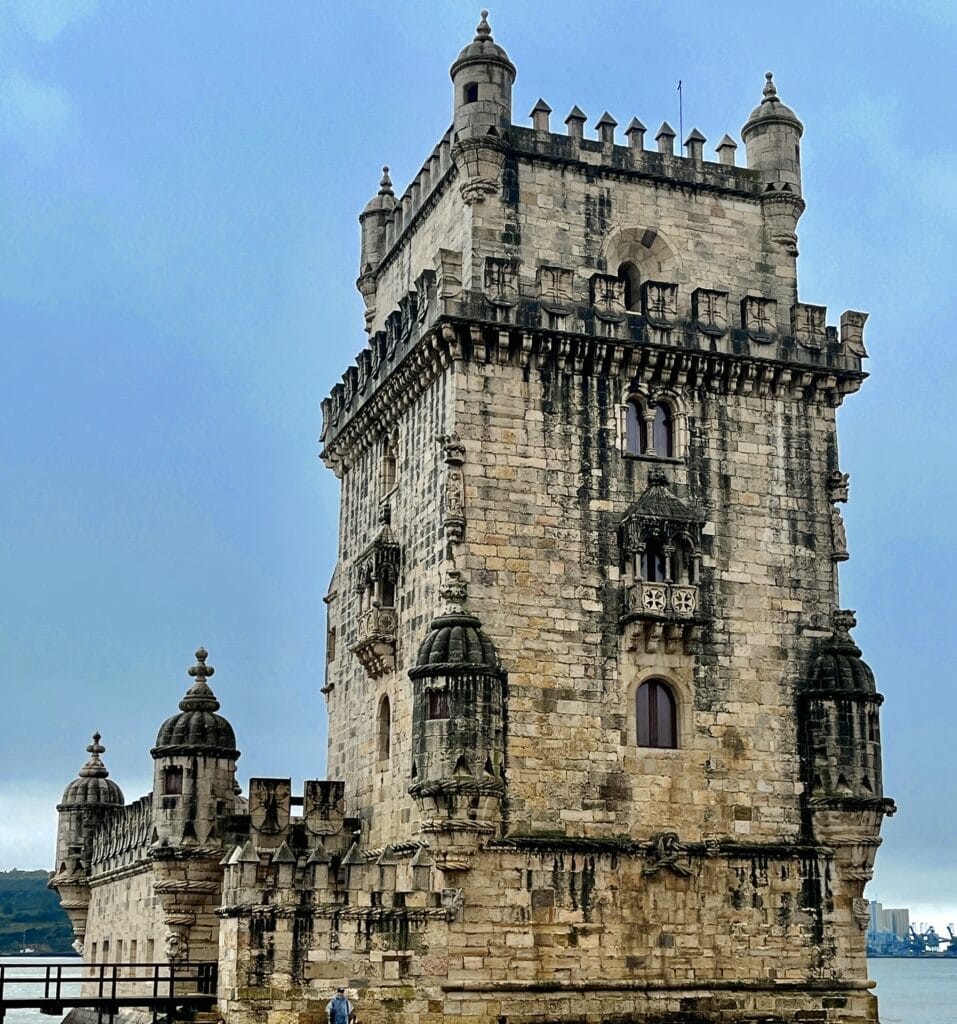
Cabo da Roca
After exploring the morning cultural landmarks, we set off to drive and visit Cabo da Roca, the westernmost point of Portugal and continental Europe. It’s an easy 35km drive from the Belém Tower.
Upon our arrival, we parked below the lighthouse. The Cabo da Roca Lighthouse stands at 165m above sea level and is the third oldest operational one in Portugal.
Walking around the coastline and witnessing the ocean crashing into the rocks below is truly breathtaking.
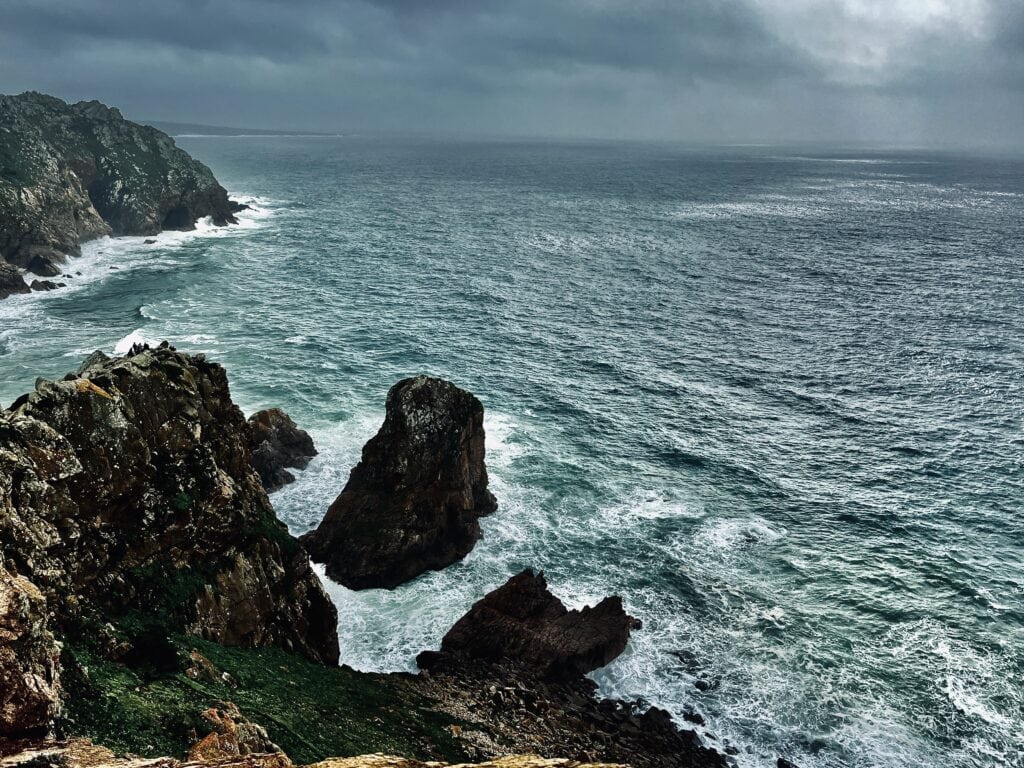

Day 3: Lisbon
Castelo de São Jorge
It was time to explore the heart of Lisbon. In the morning, we took the metro “blue” line to the Terreiro do Paço station. From there, we walked uphill to the castle, Castelo de São Jorge. The castle boasts a long and rich history, originally built as a Roman fortified castle dating back to the 11th century. It became the Royal residence in the 12th century. The major earthquake in 1755 caused significant damage throughout Lisbon, including the castle. However, the fortified walls and towers did survive. The walk around the castle area and on the walls offers a beautiful view of the entire Lisbon.



Elevador de Santa Justa
After exploring the castle area, we started the descent to the city. The next stop was to see the Elevador de Santa Justa. The elevator connects the bottom and top parts of Lisbon. It was designed by Raoul de Mesnier du Ponsard, who collaborated with Gustave Eiffel (yes, the man behind the famous Eiffel Tower in Paris). The elevator is undoubtedly one of the top tourist attractions in Lisbon. We passed by twice, and there was always a long queue to get in. And this was only February, during the low tourist season.


Rua Augusta, Arco Triunfal and Praça do Comércio
We continued our walk on Rua Augusta. It is a lively pedestrian zone in Lisbon with many shops and restaurants. It leads toward the Arco Triunfal and on to Praça do Comércio, one of the largest squares in Portugal. The square ends at the riverbank, and there is a lovely walk alongside the river to stroll on.



Time Out market (Mercado da Ribeira)
From the Praça do Comércio square, we continued alongside the river in the direction of the Ponte 25 de Abril bridge. It takes about a 15-minute walk to reach the Time Out market, also known as the Mercado da Ribeira. It is one of the best hangout spots in Lisbon, a vast space with a wide variety of different cuisines to choose from. Just a perfect place for lunch or dinner.


Carmo Convent
After a late lunch at the Time Out market, we walked towards the Carmo Convent. It was about a 15-minute walk back towards the city center. Carmo Convent dates back to the medieval age and is one of the most important religious ruins in Lisbon. The history of the Convent goes back to the 14th century, and like many other buildings, it was severely destroyed by the earthquake in 1755. It was never fully rebuilt. Throughout the visit, we saw the destroyed part as well as the area which was saved. There is a nicely done animated video in one of the halls explaining the history of the Convent.



Day 4: Sintra. Nazaré.
Sintra
The following day of our Portugal road trip, we left Lisbon behind and drove to Sintra. Unfortunately, the weather was not on our side, and it rained since the morning. Sintra is about 30 km away from Lisbon, and the drive took us about 30 minutes. It is, in fact, an ideal place for a day trip from Lisbon if you base yourself there. Our plan was to visit Sintra for a day and continue to Nazaré later in the afternoon.
Sintra is a small but very charming town to walk around, but the top attractions are the palaces, namely the Pena Palace. Pena Palace is located on the top of the hill about 20 minutes’ drive from Sintra. It is good to know that cars (unless it is a tourist bus or taxi) are not allowed there.
The best way to visit Sintra is to park the car just a bit outside (still walking distance) and catch the 434 and 435 tourist bus services. The buses operate from 8:50 in the morning with one intention – to take tourists who want to visit the palaces. The day ticket is 13.50 Euro/person, and it allows as many rides as you want.


I parked the car at the Sintra station paid parking place, a literally 1-minute walk from the 434 tourist bus station.
We took the bus to Pena Palace. I didn’t have tickets as February is not considered a high tourist season, and we reached the Pena Palace by 9:30 am, which is the opening time. I purchased the entry tickets from the vending machine and got the 10 am slot to enter. So visiting in the high season would probably require buying entry tickets ahead of time.
While buying the entry tickets, there is also an option to add a transfer from the gate to the palace entry. I didn’t take this option and rather took a 10-minute walk uphill through the beautiful gardens to reach the palace. The entry is managed by time slots, and they do not allow anyone even a few minutes before the dedicated time.



After visiting the Pena Castle, my plan was to continue to the Moorish Castle and explore it. Unfortunately, the rain kept pouring, and we decided to give it a miss. A good reason to come back. We took the bus back to town, had a coffee and a snack, and walked around the small charming city. I also contemplated visiting the Sintra National Palace, but the enthusiasm was not there given the bad weather. All said, we still left Sintra only around 2 pm. So it is the city where you can easily spend the entire day.


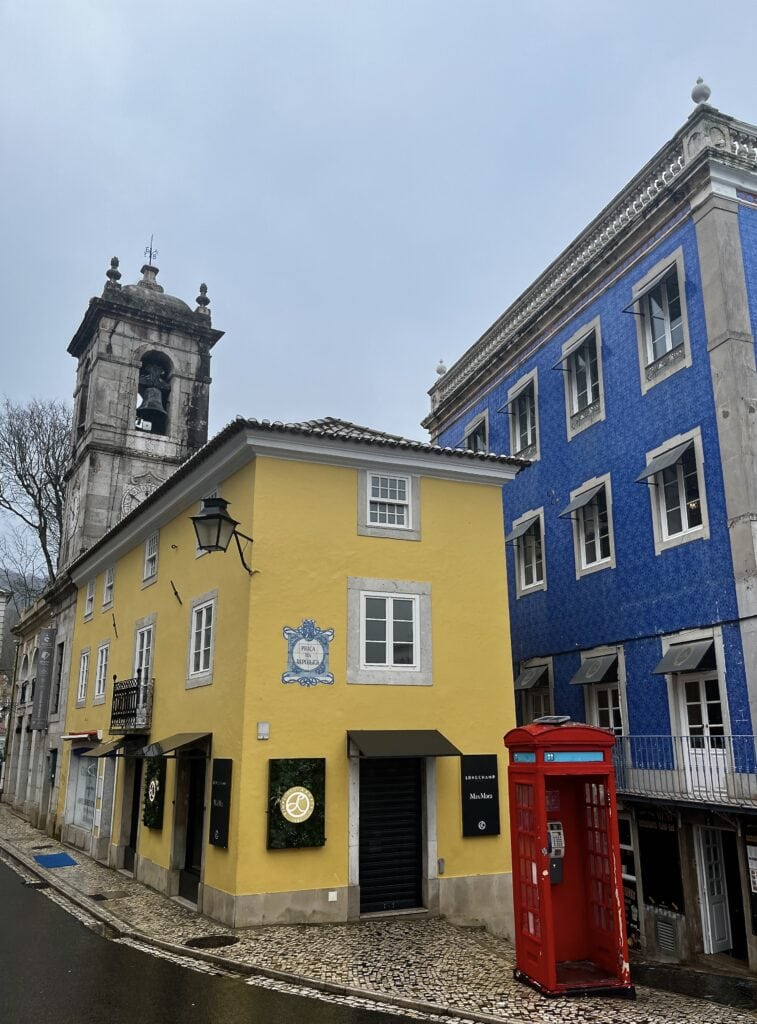
Nazaré
We left Sintra in the afternoon and drove to Nazaré. The drive took approximately 1.5 hours, an easy cruise with most of it on a highway. I booked us into Apartments Mare, conveniently positioned in the middle of the Nazaré hill. The apartments have a spacious underground garage to park the car.
After checking in, we went to explore the top part of Nazaré – the Sítio. It is the place where people watch the most adventurous surfers riding the giant waves in some weeks during the year. There are stairs along the hill leading up with fantastic views of Nazaré, the beach, and the coastline. The first stop on the track was the Ladeira do Sítio – a huge panoramic swing.
After reaching the plateau, we saw the Sítio main square. A few open stands scattered around offer refreshments. We bought a fantastic mixture of nuts from one of the lady sellers. Continuing down, the road eventually leads to the small fortress with a lighthouse, the point to watch the surfers.
Unfortunately, we were not lucky enough to experience this, but I have been watching many videos from the event, and it was amazing to experience the vibe of the spot in person. We saw the Nazaré funicular track on the top of the hill connecting it to the bottom part of the village, but it was not operational.
Walking the same panoramic staircase route, we went down back to the village and then wandered through the streets all the way to the beachfront area. We found a lovely Indian restaurant to finish the day off.

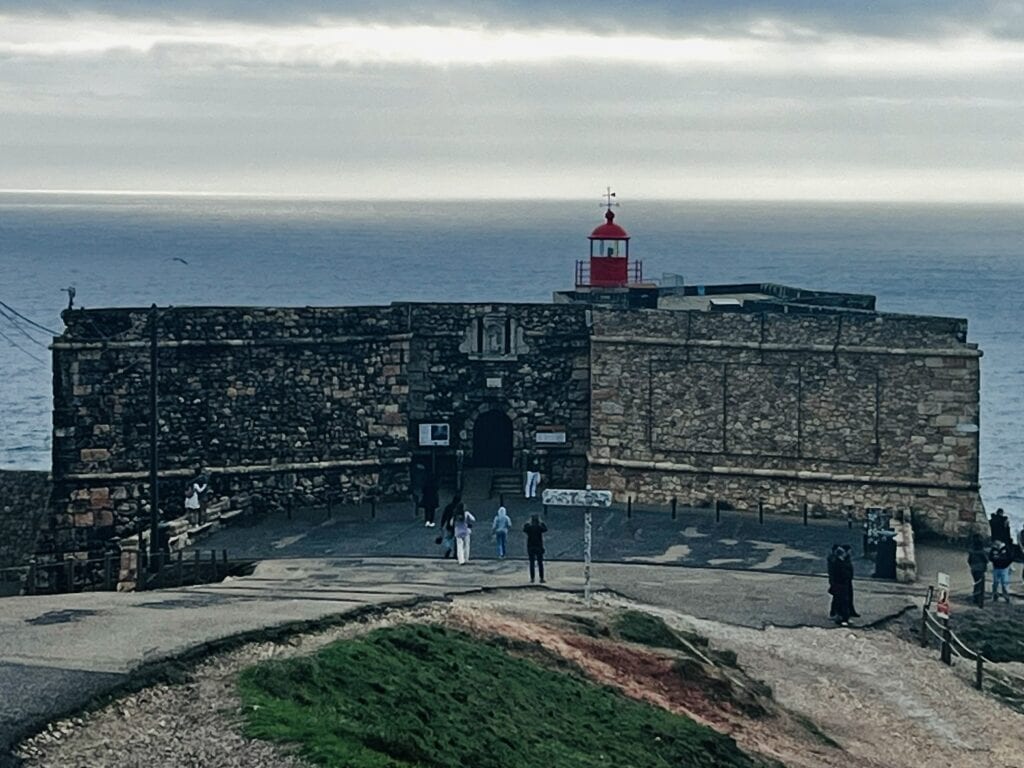

Day 5: Óbidos. Peniche. Nazaré
The following day, we made a day trip from Nazaré to Óbidos and Peniche. The drive from Nazaré to Óbidos takes about 35 minutes, on the same highway we arrived on the day before in the direction back to Lisbon. I knew that we would make this short travel backward but decided to settle in Nazaré for 2 nights rather than do 1 night in Óbidos or Peniche and then continue to Nazaré for the next one. It was a wise decision, as Nazaré has the real surfer’s vibe to enjoy.
Óbidos
Óbidos is a small medieval town surrounded by walls that can be walked on. We parked conveniently in the big free parking area and entered the town through the main gate. There awaits a charming town with cobblestone streets, old churches, a castle area, and walls to walk on for a view from the top. It is small enough to wander around without getting lost. After visiting the churches and walking on the walls, we returned to the main streets to explore the shops and, most importantly, taste Ginja.
Ginjinha is a traditional drink made from sour cherries soaked in alcohol. There is the original version served in small cups or the chocolate one. We chose the chocolate; the shot comes in a small chocolate cup and is delicious. We couldn’t resist buying a bottle to take home with us.

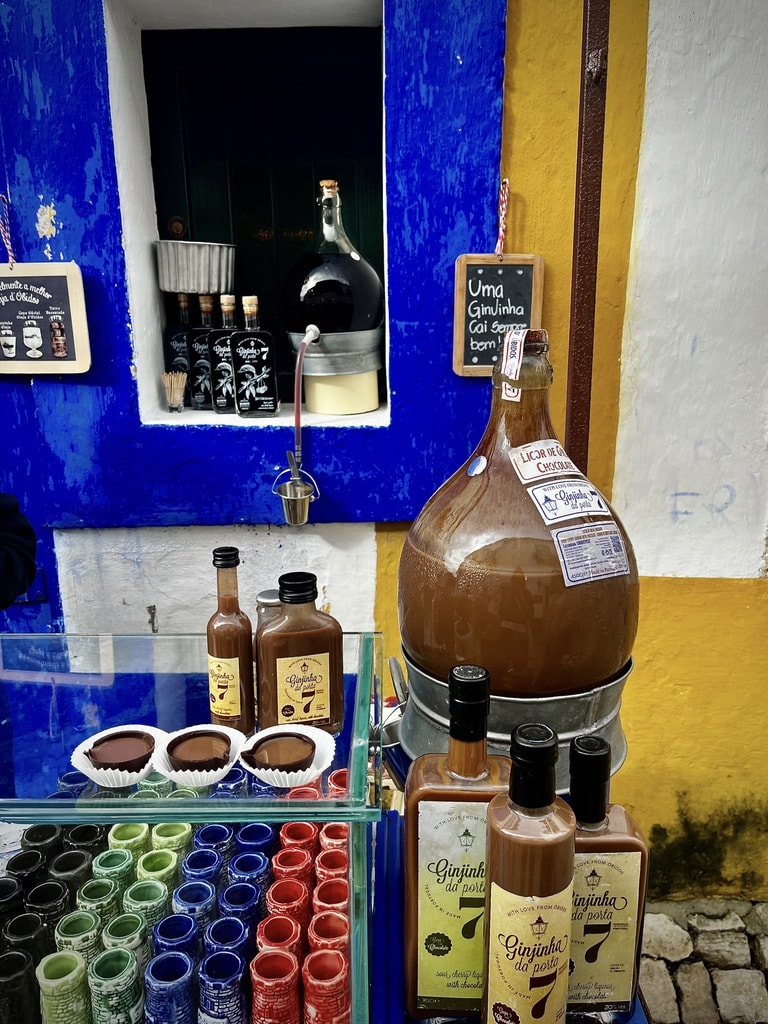

Peniche
We spent about 2.5 hours in Óbidos, then set off for the drive to Peniche, which took about 15 minutes. There isn’t much to see in Peniche town, but the drive and walk on the coastline are beautiful. We first drove to the lighthouse and were lucky enough to spot a dolphin playing in the waves. Then we drove back alongside the coastline and parked at the spot where one of the big ships full of copper, silver and gold wrecked into the ocean in 1784. Walking around the rocks offers fantastic views of the Atlantic Ocean.
Finding a restaurant for a late lunch was challenging, but we eventually found a spot. While it may not have been the most amazing, we grabbed a burger and coke there.
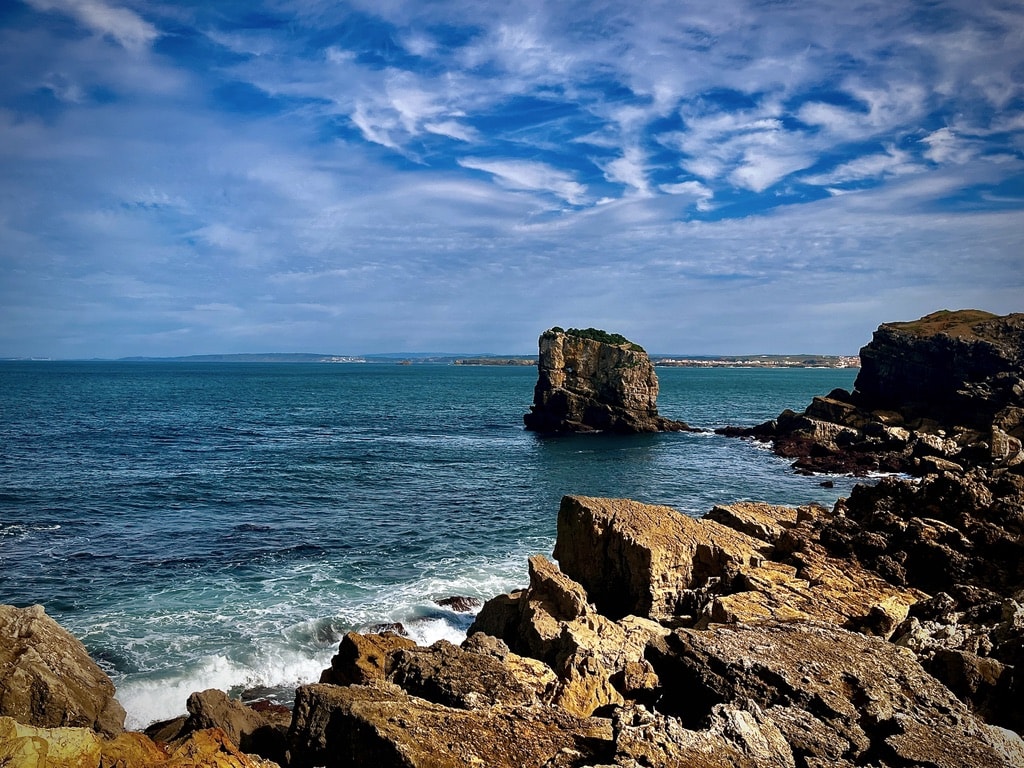


Back in Nazaré
In the evening, we spent time in Nazaré, wandering around the beachfront area where the Nazaré carnival was happening. The beachfront street was filled with people in costumes, alegoric carnival-decorated vehicles, and a stage with live music, creating a lovely atmosphere to enjoy.
Day 6: From Nazaré to Porto. Stop over in Coimbra
Coimbra
The drive from Nazaré to Porto is approximately 215 km, taking around 2 hours on the highway. While on the road, we decided to make a quick stopover in Coimbra, located approximately halfway. The main attraction in Coimbra is the University Campus, one of the oldest in the world. I parked the car in the underground garage under the local market place.
We walked uphill to reach the University, passing by and visiting the Old Cathedral on the way up. The University Campus is large and interesting to see, providing a view of the city. Walking around, we ended up on the main street in the bottom part of Coimbra, where we had coffee and a muffin before making our way back to the car.
In summary, Coimbra is okay for a quick in-and-out visit on the way to another destination. However, I would not choose to make it my primary target destination and stay overnight there.

Arrival to Porto
We drove from Coimbra to Porto airport to return the car to Hertz. I decided that we didn’t need the car while staying in Porto. Upon returning to the car, I called Bolt (a service similar to Uber) to our hotel, Apart Hotel Oporto Anselmo.
We started exploring Porto in the early afternoon. The main objective was to get oriented in the city and see the locations of the landmarks we wanted to visit. Porto is a city to walk around—unless you are a Hop-on-Hop-off bus fan. It is available in Porto (as in majority of big cities in Europe), but I do not use it. I prefer exploring the city on foot. We walked through the city to the bottom part called Ribeira.
Ribeira is one of the most colorful and liveliest areas in Porto. It spreads alongside the Douro River, and one of the major Porto attractions, the Dom Luis Bridge, is right there.
The Ponte de Dom Luis I was designed by the architect Teófilo Seyrig, who was, by the way, the business partner of Gustave Eiffel (yes, the one who designed and built the Eiffel Tower). We walked on the bottom part across the river on the day, leaving the top one for the following day. It is definitely worth crossing both the bottom and the top parts.


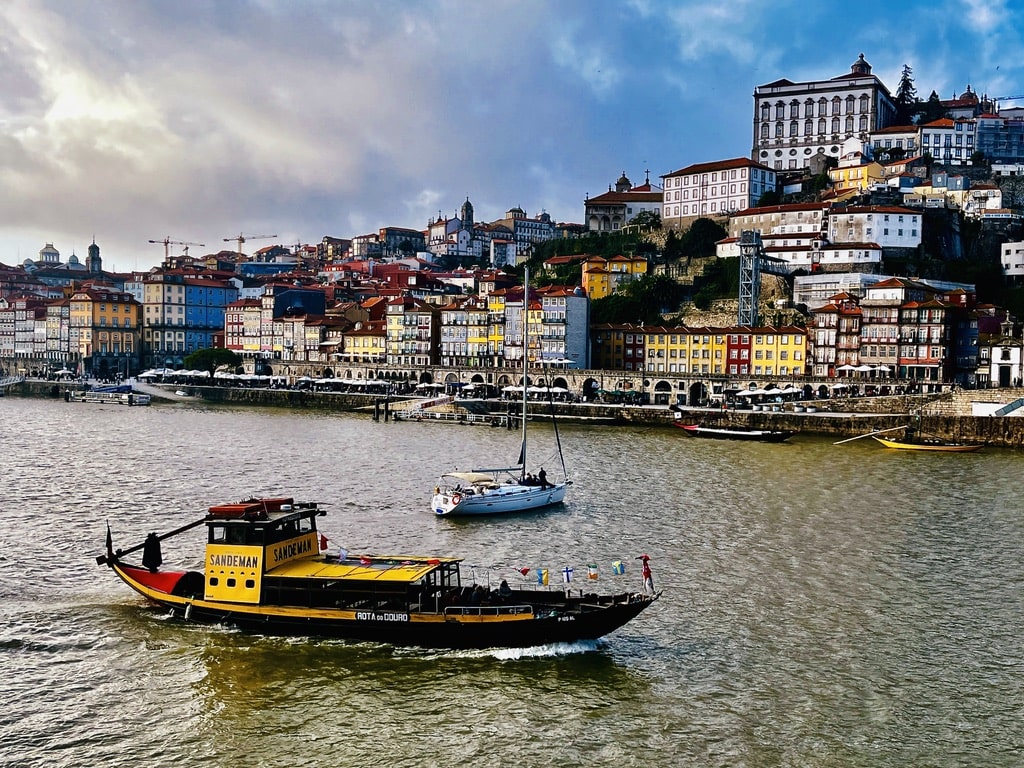
Day 7: Porto
The last day of the trip was fully dedicated to Porto. And there is so much to see.
Porto Cathedral
Originally built in the 12th century, Porto Cathedral has undergone alterations through the years, creating a mix of Romanesque, Gothic, and Baroque styles. Similar to other cathedrals we visited, it features an inside courtyard with vaulted ceiling corridors. From the top part, there is a view of Porto.



Top part of the Dom Luis Bridge
When we finished exploring Porto Cathedral, we walked towards the top part of the Dom Luis Bridge. Crossing the bridge at the top offered a different perspective of the city.
On the other side of the bridge, there is an entry to the Teleférico de Gaia cable car. It runs alongside the river, probably providing a nice view over the Ribeira. Nevertheless, we decided against taking the ride and instead continued on foot.


Church of São Francisco
We crossed the bridge at the bottom part once again and stopped on the Ribeira side for a coffee overlooking the river. After that, we continued and visited the Church of Sao Francisco. It is definitely a place not to be missed. It is, for a reason, one of the most outstanding churches in Porto because of the interior decoration. It consists of wooden carvings all decorated by about 300kg of gold. One of the standing-out sculptures represents the Jesus family tree.
After visiting the church, we also explored the monastery part, where they sell the entry tickets. We looked at the catacombs where the monks are buried and at the halls on the first floor.



There are so many places to visit in Porto, and with limited time, one needs to choose. We passed by some of them without entering inside. Some notable ones include The Palácio de Bolsa, the headquarters of the Commercial Association in Porto and a conference center, or the Clérigos Tower with the adjacent church. The Clérigos Tower is one of the tallest in Porto, and it’s hard to miss. The climb up 240 stairs suggests that there will be a stunning view over the city.
Livraria Lello
We chose to see Livraria Lello, the library believed to have inspired some Hogwarts scenes from the famous Harry Potter movie. Located close to the Clérigos Tower, it is clearly one of the big attractions with a line of tourists standing in front. Entry tickets with a time slot can be purchased only online at their official website livrarialello.pt. We secured the tickets on the day, but it might be a good idea to plan the visit a bit more ahead.
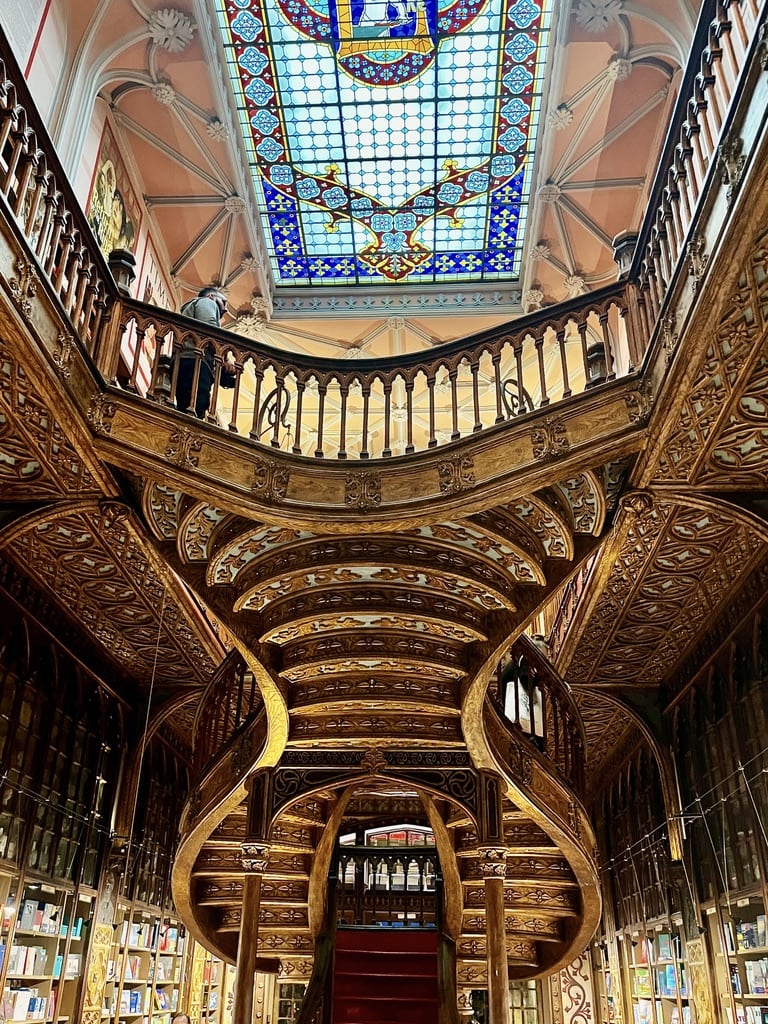


Day 8: Return to Prague from the Portugal road trip
We had an early morning flight to catch from the Porto airport. I pre-ordered Bolt the night before to avoid the morning stress and hassle.

